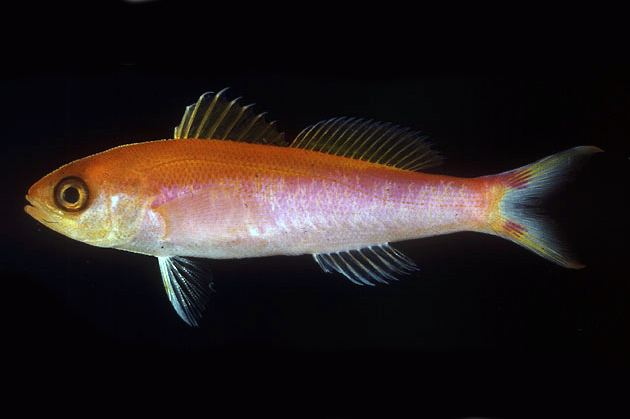Earle's Splitfin, Luzonichthys earlei Randall 1981

Earle's Splitfin, Luzonichthys earlei, from Maile Point, Oahu, Hawaii. Source: John E. Randall / FishBase. License: CC by Attribution-NonCommercial
Summary:
A small slender anthiine with a yellowish-orange snout, upper head and back, and the rest of the body pink to magenta with a silvery sheen on the cheek, gill cover and midsides.
Cite this page as:
Bray, D.J. 2020, Luzonichthys earlei in Fishes of Australia, accessed 19 Apr 2024, https://fishesofaustralia.net.au/Home/species/5027
Earle's Splitfin, Luzonichthys earlei Randall 1981
More Info
|
Distribution |
Occurs at Christmas Island (Indian Ocean) in the Australian EEZ. Elsewhere the species occurs in the tropical Indo-west-central Pacific. Forms large feeding aggregations on outer reefs, often on steep reef slopes in 15-205 m. |
|
Features |
Dorsal fin X + 16-17; Anal fin III, 7; Pectoral fin 19-21; lateral-line scales 59-68; Gill rakers 6-9 + 19-22. Body slender, depth 3.6-4.1 in SL; caudal fin deeply forked. |
|
Size |
5.5 cm TL |
|
Similar Species |
The similar Seaver Splitfin, Luzonichthys seaver, differs in having a yellow head, upper half of body, and dorsal and anal fins (vs. orange in L. earlei), and in the yellow caudal fin with bright pink blotches on the base of both caudal lobes (vs. drab, diffuse orange blotches and pale yellow distal caudal lobes in L. earlei). |
|
Species Citation |
Luzonichthys earlei Randall, 1981, Mar. Freshw. Aquar. 4(9): 14, fig. 4. Type locality: off Maile Point, Waianae coast, Oahu Island, Hawaiian Islands. |
|
Author |
Bray, D.J. 2020 |
|
Resources |
Earle's Splitfin, Luzonichthys earlei Randall 1981
References
Allen, G.R. & Erdmann, M.V. 2012. Reef fishes of the East Indies. Perth : Tropical Reef Research 3 vols, 1260 pp.
Allen, G.R. & Steene, R.C. 1988. Fishes of Christmas Island Indian Ocean. Christmas Island : Christmas Island Natural History Association 197 pp.
Allen, G.R., Steene, R.C. & Orchard, M. 2007. Fishes of Christmas Island. Christmas Island : Christmas Island Natural History Association 2 edn, 284 pp.
Copus, J.M., Ka'apu-Lyons, C.A. & Pyle, R.L. 2015. Luzonichthys seaver, a new species of Anthiinae (Perciformes, Serranidae) from Pohnpei, Micronesia. Biodiversity Data Journal 3: 1-11. https://doi.org/10.3897/BDJ.3.e4902
Heemstra, P.C. & Randall, J.E. 1999. Family Serranidae. pp. 2442-2548 in Carpenter, K.E. & Niem, T.H. (eds). The Living Marine Resources of the Western Central Pacific. FAO Species Identification Guide for Fisheries Purposes. Rome : FAO Vol. 4 2069-2790 pp.
Hobbs, J-P.A., Newman, S.J., Mitsopoulos, G.E.A., Travers, M.J., Skepper, C.L., Gilligan, J.J., Allen, G.R., Choat, H.J. & Ayling, A.M. 2014. Checklist and new records of Christmas Island fishes: the influence of isolation, biogeography and habitat availability on species abundance and community composition. Raffles Bulletin of Zoology Supplement 30: 184–202
Kuiter, R.H. 2004. Basslets, Hamlets and their relatives. A comprehensive guide to selected Serranidae and Plesiopidae. Chorleywood, UK : TMC Publishing 1, 216 pp.
Myers, R.F. 1999. Micronesian Reef Fishes. A comprehensive guide to the coral reef fishes of Micronesia. Guam : Coral Graphics vi 330 pp. 192 pls.
Randall, J.E. 1981. Luzonichthys earlei a new species of anthiine fish from the Hawaiian Islands. Marine and Freshwater Aquarium 4(9): 13-18.
Randall, J.E. 2007. Reef and shore fishes of the Hawaiian Islands. Honolulu : University of Hawai'i 546 pp.
Randall, J.E. & McCosker, J.E. 1992. Revision of the fish genus Luzonichthys (Perciformes: Serranidae: Anthiinae), with descriptions of two new species. Indo-Pacific Fishes 21: 1-21 pls I-II
Sadovy, Y.J. 2010. Luzonichthys earlei (errata version published in 2017). The IUCN Red List of Threatened Species 2010: e.T154695A115223293. https://dx.doi.org/10.2305/IUCN.UK.2010-4.RLTS.T154695A4608635.en. Downloaded on 26 November 2020.

